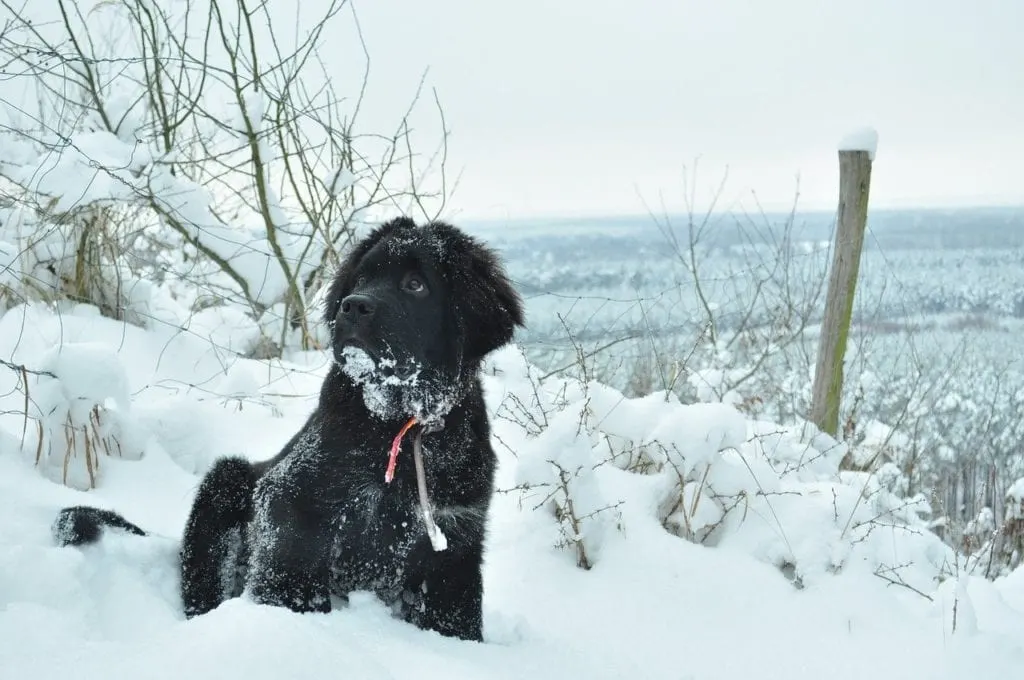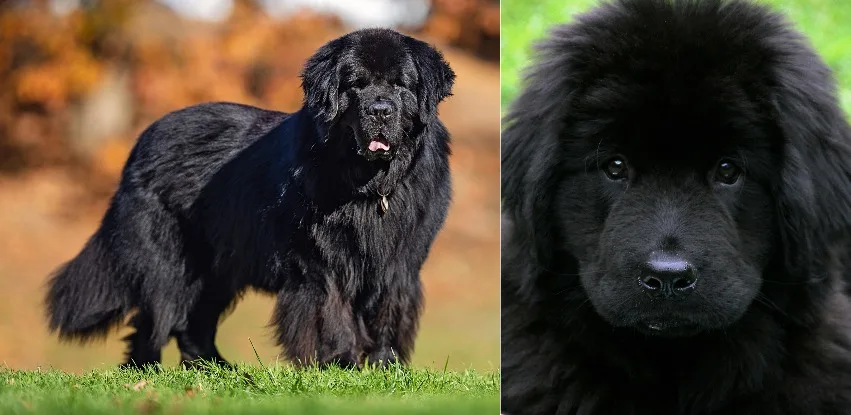If there’s one breed whose name no one really knows how to pronounce it’s the Newfoundland dog! And if you now say you know how to pronounce it, just stop! Did you know how to pronounce it the first time you read about this dog? I didn’t think so!
I know I had a hard time because I thought you pronounce it like New-found-land. But no! It’s actually pronounced Nyoo-fuhnd-luhnd.

But, it’s not only the name of this breed that is so special, its traits are too! This breed is a combination of immense strength and sweet nature. You could say that they are the gentle giants of the canine world. And they are also recognized by the American Kennel Club. The AKC officially recognized this breed in 1886.
Now, let’s learn a bit more about this breed.
Newfoundland Dog
As the name suggests, the Newfoundland dog originally came from the Canadian island of Newfoundland. It developed from crosses of large native dog breeds, such as the Black Bear Dog, a breed introduced by the Vikings in 1100. In the 18th century the English captain Cartwright first mentioned the breed as “Newfoundland dog”.
ALSO READ Full Grown Maltipoo: How Big Do They Get?
Because of their size and strength, they were used as working dogs that pulled fishing nets and worked as water rescue dogs. Fishermen used their large four-legged friends primarily as work animals.
Did you know that Newfoundland dogs were so attached to the water that they even developed webbed feet?
But, even though the days of working at the deck are long gone, they are still considered the best water-rescue dog in the world.
What they look like
The Newfoundland dog is a large dog, they have a massive, sturdy build and a majestic, serene charisma.
Male Newfs are around 28 inches tall and weigh from 130 to 150 pounds! Female Newfoundlands are a bit smaller, with 26 inches weighing from 100 to 120 pounds.
The Newfoundland has a flat, water-resistant double coat. The outer coat is coarse and long, and the undercoat is soft and dense. Its coat is medium in length and straight, with some slight waves but no curls. The hair is finer and shorter on the head, ears, and muzzle. There is also plenty of feathering on the legs.
| Dog Breed Group: | Life Span: | Height: | Weight: |
| Working Dogs | 8 to 10 years | 2 feet, 1 inch – 2 feet, 5 inches | 100 to 150 pounds |
These dogs come in several colors, including solid black, brown, gray, or Landseer, a white coat with black markings. Because their coat is so thick, they need regular brushing, at least two to three times a week.
The life expectancy of Newfoundland is between 8 and 10 years.
Personality & Temperament
The Newfoundland dog is big and looks intimidating, but they are sweet and kind! They are like a big Teddy you can cuddle with. If you’re wondering if these dogs make good family pets, they do! They are amazing with children and really love being around them. Newfoundland is devoted, gentle, and sweet. Newfs are excellent with children and in some cases, they act as a nanny.
Besides this, they are intelligent and want to please their owners. This means that training them won’t be an issue.
These dogs love their family so much and are the happiest when they are with you and can spend time with you. So, please don’t leave them alone for too long, they might become a bit destructive out of boredom.
ALSO READ Black and brown dogs: The most beautiful breeds
We can’t stress enough how important early socialization and training is for every breed! No matter if it’s a Poodle, German Shepherd, or in this case a Newfoundland. They need exposure to many people, places, sights, animals, and experiences while they are still young. Only that way will they grow up into well-behaved and well-rounded dogs.
If you don’t have time to train your dog, you can get help from a professional or enroll them in a puppy kindergarten where they will learn everything.
Health & Lifespan
There is no breed that won’t ever have health problems. Every dog will at some point will one health problem or the other. Newfoundland dogs are no exception. They are susceptible to many health conditions.
The most common health problems among Newfoundlands are:
- Addison’s Disease – A serious condition that is caused by an insufficient production of hormones by the adrenal gland. The symptoms of Addison’s disease are vomiting, poor appetite, and lethargy.
- Epilepsy – It’s usually a hereditary condition and causes seizures which can be mild or severe. Epilepsy can also be caused by metabolic disorders, infectious diseases that affect the brain, tumors, exposure to poisons, severe head injuries, and more. You should know that a seizure can look like running frantically as if being chased, staggering, or hiding.
- Hip dysplasia – We talk about hip dysplasia a lot, because it’s probably the most common hereditary condition in dogs. It’s when a dog’s thighbone doesn’t fit snugly into the hip joint. This can lead to severe pain for the dog and even arthritis.
ALSO READ Puppy strangles: What it is and why it occurs
- Hypothyroidism – A disorder of the thyroid glands which can lead to epilepsy, hair loss, obesity, lethargy, dark patches on the skin, and other skin conditions.
- Cherry eye – When a dog’s third eyelid swells, it looks like a red mass or a cherry. The only treatment is surgery.
- Cataracts – Just like humans can get cataracts, dogs can too. If your dog has cataracts then they will have cloudy spots on the eye lens. These spots grow with time. Just like the cherry eye, cataracts are also removed surgically.
- cancer – Symptoms of cancer are abnormal swelling of a sore or bump, sores that do not heal, bleeding from any body opening, and difficulty with breathing or elimination.
Taking Care of the Newfoundland Dog
The Newfoundland is an all-around dog, suited for work in the field and the water. These are strong dogs that need at least 30-minute exercise every day to stay healthy. Newfs love running, swimming, pulling carts, long walks, and hikes.
Newf’s heavy, dense coat sheds a lot. Therefore, brush your Newf at least once a week. However, during the shedding season in spring and autumn, you will need to brush your dog daily.
Bathe your Newfoundland dog every one to two months and trim his nails every month.
Also, brush your Newf’s teeth daily to prevent bad breath and gum disease.
ALSO READ Puppy crying: Why your dog whines when sleeping
High-quality food and a well-balanced diet are essential for the health and wellbeing of your Newfoundland dog. Therefore, make sure you provide nutritious, high-quality food your dog likes and stick with it. Also, keep track of your dog’s weight and portion his meals accordingly.
Newfoundland dog is intelligent, eager to please, and curious. Therefore, Newfs are easy to train and they respond well to gentle training methods. However, if you are using harsh training methods, you won’t accomplish much.

